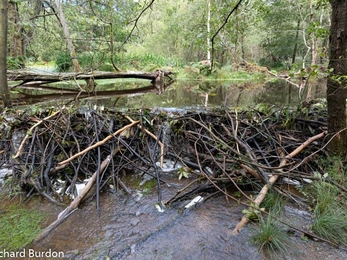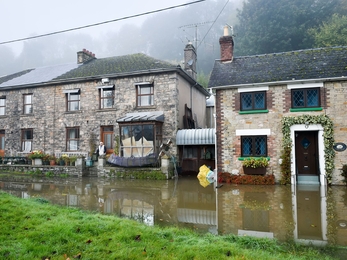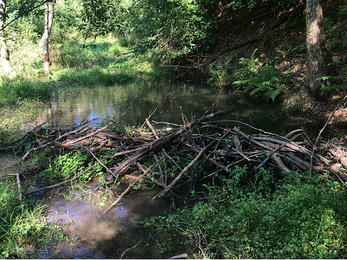Dr Roger Auster of Exeter University has done just that, by studying the perspectives of community members living downstream of three beaver enclosures across England (Auster et al., 2022). His study focussed on residents living in Ladock in Cornwall located downstream of the Cornwall Beaver Project where a pair of beavers were released in 2017; in Sinnington in Yorkshire downstream of a beaver enclosure on Forestry England’s Cropton Forest where a pair of beavers were released in 2019; and in Lydbrook in Gloucestershire downstream of a beaver enclosure on Forestry England land in the Forest of Dean where a pair of beavers were released in 2018. All three villages have suffered multiple flood events.
Living downstream of beavers - residents’ perspectives five years on from release on mainland Britian
Beavers are back in Britain, with upwards of 25 releases of these industrious rodents into enclosures having taken place in England over the past 20 years. It is estimated that approximately 400 beavers are now living in England (Heydon et al., 2021) with a further 1,000 or so north of the border in Scotland (Campbell-Palmer et al., 2021).
As its international beaver day, it seemed timely to see how these reintroductions are being perceived by those most impacted, the local residents living downstream of these enclosures.
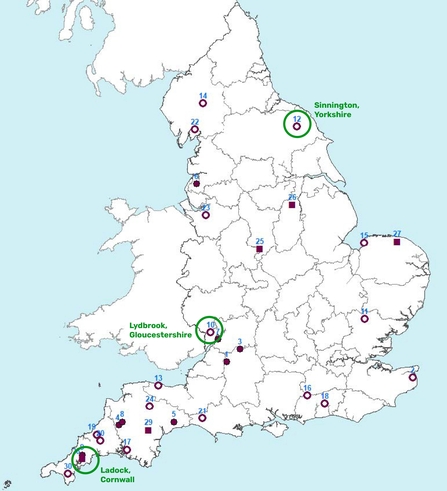
© Natural England - Beaver reintroductions in England 2000 - 2021
Thirty-nine participants responded to Dr Auster’s survey on beaver perceptions, thirteen from each village. Of these, thirty respondents had personally experienced flooding, with five in Ladock, eight in Sinnington and nine in Lydbrook having been flooded after moving to those villages.
The Results
Perhaps unsurprisingly given the sometimes dramatic impacts that beavers can have on the landscape, opinions of the residents on their upstream ecosystem engineers were mixed, although broadly twenty-three respondents were in favour of the beaver reintroductions and nine were against, while the rest were more mixed in their responses.
To understand more clearly what factors motivated these divergences in opinion, Dr Auster separated the respondents by key recurring themes that explained their viewpoints.
Pro-beaver motivations
Ecology
Of those that were in favour of their beaver neighbours, sixteen respondents (five from Ladock, six from Sinnington and five from Lydbrook) were characterised as being “eco-centric”. These folk strongly agreed that flood management measures should work with nature and help to restore natural environments. These respondents agreed more than the others that flood management measures must also benefit wildlife and that beavers would provide such a benefit. Several people from all three villages were of this opinion, with a respondent from Lydbrook saying:
“I think it's imperative that flood management works with nature, particularly at this critical time of climate change.”
And another from Ladock reporting:
“I'm happy, even proud, to have beavers living close by.”
Nature watching
Similarly to those above, four people (two from Sinnington and two from Lydbrook) felt positively towards beavers, principally by the opportunity of getting to see beavers and their wetlands first-hand. They strongly agreed that they would enjoy seeing beavers and would find it enjoyable to visit a beaver wetland. They also felt flood management should work with nature and, when compared with others, agreed most that flood management benefits must outweigh any management costs, with one resident from Sinnington saying:
'I obviously think it is marvellous that the beavers have been introduced [upstream], and feel confident that they are providing a considerable level of protection from flooding.'
Another from Lydbrook thought:
“ANY management of the environment should work with nature.”
Photos of the village of Sinnington on the River Seven in Yorkshire during flooding in 2008, and the beaver enclosure established in 2019 in Cropton Forest located on the upstream tributary Sutherland Beck. Sinnington has experienced historical flooding, including events in 1999, 2000 and 2007 (Environment Agency, 2007; North York Moors National Park Authority, 2017).
Economy
One person in favour of beavers, from Lydbrook, was positive principally due to the benefit beavers could bring to the local economy. This person believed water stored behind beaver dams would be useful in periods of drought and beaver activity would improve water quality. They strongly felt they would enjoy seeing beavers and there is a potential for beaver tourism. They indicated they would enjoy visiting a beaver wetland and felt beavers may benefit local businesses. This person strongly felt humans could not build woody dams as well as beavers can and strongly disagreed with the statement that human-built flood measures are more reliable than beaver dams from an economic perspective, saying:
“Human solutions to flooding are capital intensive and require ongoing maintenance.”
Ecosystem services
Two people, one from Sinnington and one from Lydbrook, felt positively towards beavers due to the benefits that their activities can bring for people. These folks were the most pleased of all to have beavers upstream of their property and were not worried that beavers lived nearby. More-so than others, they believed beavers were good for people overall and the benefits of beaver outweighed management costs, with one resident from Lydbrook saying:
“I think it[']s a great idea having beavers upstream and helping to slow the flow.'
And the other from Sinnington concluding:
“It[']s a natural solution to the flood risk - can't believe management costs would be prohibitory; seems like a worthwhile investment.”
Photos of the village of Lydbrook on the banks of the River Wye in Gloucestershire during flooding in 2019, and the beaver enclosure established in 2018 in the Forest of Dean located on the upstream tributary Greathough Brook. Lydbrook has experienced multiple flood events, including in 2000, 2007 and 2012 (Environment Agency & Natural Resources Wales, 2015; Gloucestershire County Council, 2014).
Anti-beaver motivations
Human engineering
Of those that were not in favour of beaver reintroduction, five respondents (all from Ladock) were characterised as being “anthropocentric”. These folk strongly felt that human-built flood measures would be more reliable than beaver dams and that wild beavers would not build dams where flood management is required. Compared with other factors, these respondents agreed more that beavers would damage human infrastructure and cause problems for agriculture. One of these five Cornish residents of this opinion said:
“Man-made flood measures are predictable and work where they are required. Beavers are unpredictable. Beavers can flood river courses in the wrong areas, e.g. below/downstream from houses which can result in worse flooding.”
While another reported:
“If beavers dam up water courses downstream of properties they can cause flooding.”
Photos of the Cornwall Beaver Project established in 2017 on Woodland Valley Farm, and the village of Ladock located approximately 1.5 miles downstream on the Tresillian River. Ladock has experienced multiple flood events, including three which flooded 13–20 properties in 1979, 1993 and 2012 (Cornwall Council, 2011, 2012).
Wider beaver impact
In a similar vein to those above, two people from Lydbrook were against beavers but due primarily to their wider impact on the landscape. They too felt strongly that human-built flood measures are more reliable than beaver dams and humans could build woody dams as well as beavers can. But they strongly felt that beavers were not good for the environment and believed more strongly than others that beavers would have a negative impact on fish and agriculture, saying:
“Seen the damage they do???? Wait til they escape. […] If you let them go there will be problems and then you'll be spending 20 years getting rid of them.”
Management requirements
On a related note, two people (one from Sinnington and one from Lydbrook) were concerned that a wild beaver population would need to be managed and beavers would need regular monitoring, since these folks agreed more than others that beavers may cause problems for agriculture or damage human infrastructure. One resident from Ladock said:
“I think a wild beaver population would take a huge amount of management to constrain their activities where they (and they WILL) cause a problem to river flows, fish passage, tree damage, flooding etc. Once the genie is out of the bottle…”
While the other from Sinnington said:
“England is too small, developed and overpopulated with humans to cohabit with a wild beaver population without a negative impact from tree felling and dam building.”
Conclusions
From this study it’s clear to see that opinions on beavers can vary. Here, thirty-two of the thirty-nine respondents had pretty clear opinions that could be teased out around their core values, with the twenty-three respondents in favour of beavers perceiving benefits to nature, the economy and people through the delivery of ecosystem services, while the nine against beaver introductions expressed concerns about the need for beaver management, their wider impact on the environment and the unplanned nature of beaver damming.
Interestingly, people were split in their opinions across all three villages, but in general those living in Sinnington in Yorkshire were the most predisposed towards beavers, with nine respondents positive and only one against, citing concerns about long-term beaver management. Those living in Lydbrook again were mostly in favour of beavers, with again nine respondents in favour, and two against with concerns about the longevity of beaver dams and the wider impact of beavers, especially towards fish. There are a number of stocked trout fisheries in Gloucestershire around the Forest of Dean, so perhaps its not surprising that some anglers may have concerns, although data from Scotland does suggest that beaver ponds can be important rearing habitats for fish, supporting larger size classes of trout than in undammed streams (Needham et al., 2021). Folks in Ladock in Cornwall were the least in favour of beavers with only five in favour and six against, five of which felt that humans could do a better job of flood defence than beavers can. Cornwall has suffered some terrible floods in recent years, and its topography and position at the southwest tip of England surrounded by sea on three sides make it vulnerable to powerful Atlantic storms, with high run off from the inland moors and minimal drainage into the sea during high tides and storm surges compounding flood risk. Where flood risk is high, perhaps its not surprising that folk want the assurances of planned heavy engineering flood defences upstream, albeit with the high financial costs that accompany such schemes.
But with beaver dams found to have both reduced peak downstream flows and slowed peak lag times typically by 30% at five different enclosures across England, with up to 60% reduction recorded in Devon (Puttock et al., 2017 & 2021), only time will tell as beavers continue to spread across the landscape, and the evidence base continues to build, whether we will feel comfortable putting our faith in natural flood management.
To read Roger’s study in more detail, you can find his peer reviewed paper free online in the Journal of Flood Risk Management here.
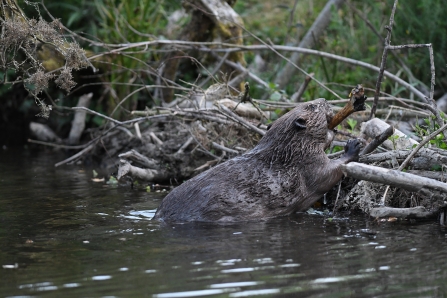
© David Parkyn/ Cornwall Wildlife Trust
References
Auster R., Barr S. & Brazier R. (2022) Beavers and flood alleviation: Human perspectives from downstream communities. Journal of Flood Risk Management. 15: e12789.
Campbell-Palmer, R., Puttock, A., Needham, R.N., Wilson, K., Graham, H. & Brazier, R.E. (2021). Survey of the Tayside Area Beaver Population 2020-2021. NatureScot Research Report 1274.
Heydon M., Pouget, Da, Gray, S., Wagstaff, G., Ashton, M. & Andison, E. (2021). Beaver Reintroductions in England: 2000 – 2021. JP036. Natural England, York.
Needham R., Gaywood M., Tree A., Sotherton N., Roberts D., Bean C. & Kemp P. (2021) The response of a brown trout (Salmo trutta) population to reintroduced Eurasian beaver (Castor fiber) habitat modification Canadian Journal of Fisheries & Aquatic. Sciences 00: 1–11
Puttock A., Graham H., Cunliffe A., Elliott M. & Brazier R. (2017). Eurasian beaver activity increases water storage, attenuates flow and mitigates diffuse pollution from intensively-managed grasslands. Science of the Total Environment 576: 430–443
Puttock A., Graham H., Ashe J., Luscombe D., & Brazier R. (2021). Beaver dams attenuate flow: A multi-site study. Hydrological Processes 35: e14017.


